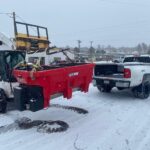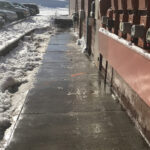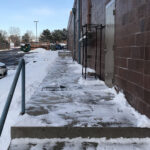Colorado Ice Melt and Deicing Services
Ensuring Safety and Accessibility in Winter
Winter in Colorado can be both picturesque and challenging. The state’s climate brings significant snowfall and temperature fluctuations, leading to icy conditions on parking lots and sidewalks. Effective ice melt and deicing practices are crucial to ensure safety and accessibility for residents and visitors alike.
Understanding Ice Melt and Deicing
Ice melt and deicing are processes used to manage and mitigate the hazards associated with ice and snow accumulation. These methods involve the use of chemical substances to lower the freezing point of water, thereby preventing ice formation or accelerating the melting process.
Types of Ice Melt Products
Several types of ice melt products are commonly used in Colorado:
- Rock Salt (Sodium Chloride): One of the most widely used deicing agents, it is effective down to about 20°F (-6°C) but can be corrosive to concrete and harmful to vegetation.
- Calcium Chloride: This chemical works well at lower temperatures, as low as -25°F (-32°C). It is fast-acting and less harmful to plants but can still be corrosive.
- Magnesium Chloride: Effective to around -13°F (-25°C), it is less corrosive than rock salt and calcium chloride and is often used in environmentally sensitive areas.
- Potassium Chloride: Safe for use around pets and vegetation, it is less effective at very low temperatures and is typically mixed with other agents.
- Urea: Often used as a fertilizer, it is safe for plants and pets but has limited effectiveness at low temperatures.
- Blends: Many commercial ice melt products are blends of the aforementioned chemicals, designed to optimize performance and reduce negative side effects.
Deicing Practices for Parking Lots
Maintaining clear and safe parking lots is essential for businesses, schools, and public facilities during Colorado’s winter months. Effective deicing practices include:
Pre-treating Surfaces
Applying ice melt products before a storm can prevent snow and ice from bonding to the pavement, making it easier to remove. This proactive approach is known as anti-icing.
Regular Monitoring and Application
During and after a storm, regular monitoring of parking lot conditions is necessary. Reapplication of ice melt products may be required to maintain safe surfaces, especially in high-traffic areas.
Mechanical Removal
In conjunction with chemical deicers, mechanical removal methods such as plowing and shoveling are essential. These methods help to physically remove snow and ice, reducing the amount of chemicals needed.
Post-Storm Cleanup
After the storm, it is important to clean up any residual ice melt chemicals to prevent them from being tracked indoors or causing environmental damage. Proper disposal of snow piles is also crucial to avoid re-freezing and creating new hazards.
Deicing Practices for Sidewalks
Sidewalks are critical for pedestrian safety and accessibility. Effective deicing practices include:
Choosing the Right Ice Melt
Selecting the appropriate ice melt product for sidewalks is important to minimize damage to pavement and vegetation. Products that are safe for pets and plants are often preferred in residential areas.
Consistent Application
Applying ice melt products consistently along the length of the sidewalk ensures uniform melting and prevents hazardous spots. It is important to follow manufacturer instructions for proper application rates.
Using Physical Barriers
Placing physical barriers such as snow fences can help reduce snow accumulation on sidewalks. These barriers can redirect wind-blown snow and minimize the need for frequent deicing.
Public Awareness and Responsibility
Encouraging residents and business owners to maintain their sidewalks is essential. Public awareness campaigns and local regulations can help ensure that sidewalks are regularly cleared and safe for pedestrians.
Environmental and Safety Considerations
While ice melt products are effective in managing snow and ice, they can have environmental and safety impacts:
Environmental Impact
Chemical deicers can run off into waterways, affecting aquatic life and water quality. Choosing products with lower environmental impact and using them sparingly can mitigate these effects.
Concrete and Pavement Damage
Certain deicers can cause damage to concrete and asphalt surfaces over time. Using products designed to be less corrosive and applying them correctly can help preserve infrastructure.
Health and Safety
Ice melt products can pose health risks to pets and humans if ingested. It is important to choose products that are safe for pets and to store them out of reach of children.
Effective ice melt and deicing practices are essential for maintaining safety and accessibility on parking lots and sidewalks in Colorado. By understanding the different types of ice melt products and implementing best practices for their use, residents and businesses can navigate winter conditions safely and responsibly. Balancing the need for safety with environmental and infrastructural considerations ensures that Colorado’s communities remain both safe and sustainable during the winter months.








